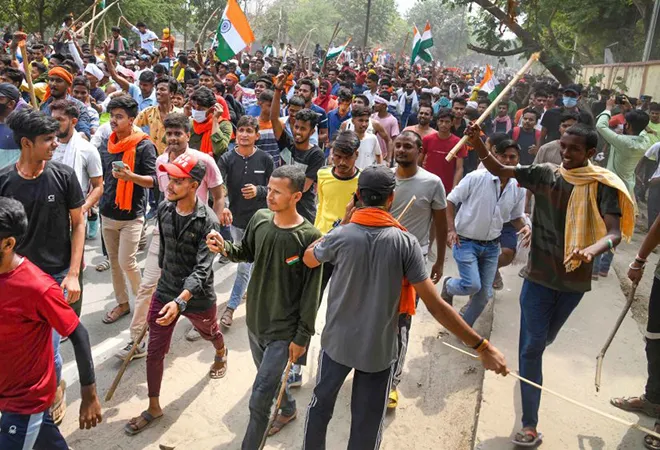 This piece is part of the essay series, The Agneepath Scheme: Radical or Irrational?
This piece is part of the essay series, The Agneepath Scheme: Radical or Irrational?
Recently, the National Democratic Alliance (NDA) government’s
Agnipath scheme for short-term recruitment across the military establishment witnessed a series of violent protests in many parts of the country. The protests which first cropped up in Bihar on 16 June, soon spread like wildfires in as many as 15 Indian states, causing massive destruction to public properties and disrupting normal life. Finally, the agitation was quelled by the government through a combination of
concessions and strong police actions. The Central government was completely taken by surprise by the nature of the protests and its intensity. What do these protests against the Agnipath Scheme signify? Why did so many youths protest against a supposedly attractive option of training and employment opportunity even if temporary?
The protestors are acutely aware that the jobs that are being offered would neither have the kind of social status nor the economic benefits that regular armed forces job holds.
The major reason cited for the violent protests is the temporary nature of the job with no post-retirement benefits that regular armed forces jobs offer. The protestors are acutely aware that the jobs that are being offered would neither have the kind of social status nor the economic benefits that regular armed forces job holds. The fact of the matter is that many aspire to military jobs due to the social status, prestige, and attractive post-retirement benefits that accompany it. However, with a four-year tenure, no medical and no retirement benefits (even for those 25 percent who would join the forces as regular cadres), it is highly disappointing. Also most importantly, only a quarter of those jobs will be retained.
Growing job crisis
The protest against Agnipath should be seen in the context of the growing job crisis across all sectors; public and private. According to a recent report from the Centre for Monitoring Indian Economy (CMIE), by end of December 2021, salaried workers accounted for only 19 percent of all employed persons (going down from 21.2 percent in 2019-20). Statistically speaking, as many as 9.5 million salaried jobs were lost in this period. Significantly, as many as 1 million jobs were lost amongst
entrepreneurs. While a significant number of jobs have been created in the intervening period, a vast majority of them are low-paid jobs in segments like construction, agriculture and other less remunerative jobs. While there were signs of recovery, India’s most recent labour statistics paint a grim picture. According to
Mahesh Vyas, the Managing Director of CMIE, India’s employment fell by a huge 13 million from 404 million in May to 390 million. So far, this was the biggest fall in employment during a non-lockdown month. According to him, employment in June was the lowest in the last 12 months.
Recruitment across all verticals particularly the regular and relatively high-paying manufacturing jobs has sharply declined for more than a decade. Beyond the numbers, the real issue in private-sector jobs is the quality of jobs.
A stagnating private sector
The private sector which has been the main pillar of new jobs in the last three decades, particularly since the commencement of economic reforms in the early 1990s is going through a patchy phase. Recruitment across all verticals particularly the regular and relatively high-paying manufacturing jobs has sharply declined for more than a decade. Beyond the numbers, the real issue in private-sector jobs is the quality of jobs. Contrary to the prevailing perception that multinational companies are good paymasters and set the market salary structures are limited to a small percentage of employees. Low-wage workers overwhelmingly dominate the private-sector workforce. What makes private-sector jobs even more unattractive is growing contractualisation with little social security cover. The issue of security of employment got amplified during the COVID-19 pandemic. Close to
11 million jobs were lost soon after the outbreak of the COVID-19 pandemic and subsequent lockdowns and related restrictions in 2021. Key sectors like aviation, travel and hospitality were particularly hit.
The growing appeal of the government job
Tenure security ensured government employees remained mostly unscathed by the impact of the pandemic and consequent economic slump. What protected government employees apart from job security is relatively high wages. For instance, according to the Periodic Labour Force Participation (PLFP) data (2019-20), while monthly average government salaries are about INR 28,000, wages in private firms are in the range of INR 17,000. According to scholar
Sonalde Desai, if one compares men with 10-12 level education, employees working in the government earn as much as INR 25,000 per month, whereas in the private sector people earn about INR 12,000 per month. Beyond comparatively higher remuneration, employees in the public sector are entitled to a host of other benefits including provident fund/pension, gratuity, and medical expenses amongst others. A vast majority of employees in the private sector barely receive these benefits. In short, the gap between government and private-sector jobs in terms of average salary, job security, and social security has grown over the years.
There is much more to government jobs than financial benefits. Government jobs offer status, social prestige and a huge opportunity for social mobility. As
analysts rightly said, government jobs confer individuals a new professional identity of a “government official”, which is deeply empowering. Further, the comfortable terms and conditions, tenure security, and regular upward revisions of salary (pay commissions) of government jobs have imprinted on the psyche of a society which barely values the market.
Beyond comparatively higher remuneration, employees in the public sector are entitled to a host of other benefits including provident fund/pension, gratuity, and medical expenses amongst others.
Yet, the harsh reality is that there are only a few jobs added to the public sector in the past decades. This is further elucidated in the
grim statistics of new recruitment. While the Central government recruited nearly 119,000 people for permanent jobs in 2020, the numbers dropped drastically to 87,423 in 2021. The situation remained even more precarious at the state levels. While states recruited as many as 496,052 in 2020, this dropped to 389,052 persons in 2021. While a lot of this has a link with the COVID-19 pandemic, there is a consistent decline in the recruitment rate of many key government departments which are known to be big recruiters. For instance, Indian Railways as one of the biggest job providers has done away with
72,000 posts at various levels. Similarly, the army has stopped recruitment for the last two years due to the pandemic. Not only has the hiring in the government departments declined drastically, but there are also growing trends of ‘temporisation’ (casual and short-term hiring).
Conclusion
While the key policy-makers in the government appeared to be
surprised by nationwide protests marred by violent incidents against a supposedly attractive scheme like Agnipath, they ought to have not missed the warning signs in the last few years. With a drastic dip in private sector employment, especially job quality and declining tenure security, youths have been desperately eyeing government jobs. While this is reflected in the record number of qualified youths (15 million) applying for a few thousand
D-category jobs in railways recently and numerous violent protests in Bihar and Uttar Pradesh over the delays in recruitment in the railways and army. Despite this, there have been no visible efforts from the government and other stakeholders. Taking note of the crisis, recently the Central government
announced to recruit a million people in mission mode within 18 months. While this is a welcome step, this is still a drop in the ocean given the extent of unemployment and the demographic bulge that India has now. Today, the working-age population is larger than our dependent population. Today, as much as two-thirds of Indians are of working age. In short, before people take to the streets in a larger number seen in recent times, governments across all verticals must pay serious attention to the growing job crisis and increasing youth disenchantment.
The views expressed above belong to the author(s). ORF research and analyses now available on Telegram! Click here to access our curated content — blogs, longforms and interviews.



 This piece is part of the essay series,
This piece is part of the essay series,  PREV
PREV


